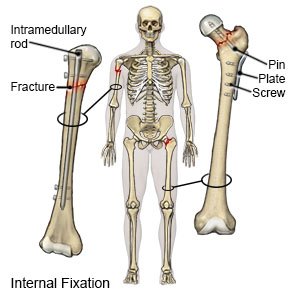Closed Reduction Internal Fixation of an Upper Extremity Fracture
Medically reviewed by Drugs.com. Last updated on May 6, 2024.
What do I need to know about closed reduction internal fixation (CRIF)?
CRIF fixes a fractured (broken) bone without opening the skin over the fracture. Metal plates, rods, screws, pins, or wires are examples of internal fixation devices. They will be used to hold the bones in place while they heal.
 |
How do I prepare for a CRIF?
Your healthcare provider will talk to you about how to prepare for surgery. He or she may tell you not to eat or drink anything after midnight the day before your surgery. You will also be told what medicines to take or not take on the day of your surgery. Arrange to have someone drive you home after surgery. You will not be able to drive yourself.
What will happen during a CRIF?
You may be given local anesthesia that numbs the body area where the surgery will be done. With local anesthesia, you will remain awake or lightly sedated during surgery. You may feel pressure or pushing during surgery, but you should not feel any pain. Your healthcare provider will use an x-ray machine to see your broken bone. The x-ray machine will show pictures on a monitor. Your healthcare provider will be able to watch the monitor while putting the pieces of bone in the correct position. Incisions will be made in the areas where the internal fixation devices will be inserted. Internal fixation devices will be placed through the incisions, into the side of the broken bones. The incisions may be closed with stitches. A splint or cast may placed to protect your surgery area.
What will happen after my surgery?
Your healthcare provider will monitor you for a short time after surgery. The area will remain numb for up to 6 hours. It is normal to have pain. Take your pain medicines before the numbness wears off completely. You may also notice swelling and bruising. The devices may be removed once your fracture starts to heal. The devices may instead be left in place. You may need to participate in physical or occupational therapies. These therapies will teach you exercises to keep range of motion in your arm.
What are the risks of a CRIF?
- You may bleed more than expected or get an infection. Your healthcare provider may not be able to position your fracture correctly using a closed procedure. After surgery, your broken bone may not heal correctly. You may continue to have pain. The internal fixation devices may break or change shape. You may need another surgery to remove the device used to hold your bones in place. Nerves, blood vessels, ligaments, or muscles may be damaged during surgery.
- You may develop a fat embolus. This is when fat is forced out of the inside of the bone and travels to other parts of your body. It can block blood flow to your lungs, brain, or heart. You may get a blood clot in your leg or arm. This may become life-threatening.
Care Agreement
You have the right to help plan your care. Learn about your health condition and how it may be treated. Discuss treatment options with your healthcare providers to decide what care you want to receive. You always have the right to refuse treatment. The above information is an educational aid only. It is not intended as medical advice for individual conditions or treatments. Talk to your doctor, nurse or pharmacist before following any medical regimen to see if it is safe and effective for you.© Copyright Merative 2024 Information is for End User's use only and may not be sold, redistributed or otherwise used for commercial purposes.
Further information
Always consult your healthcare provider to ensure the information displayed on this page applies to your personal circumstances.
